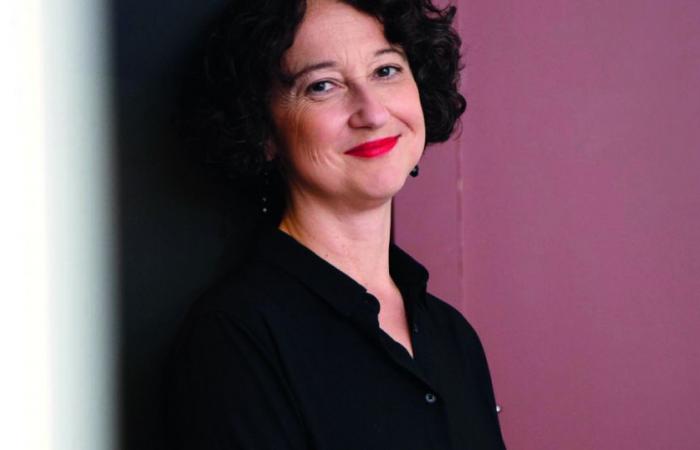INTERVIEW – Around a deceased, relatives reveal themselves. In Thomas Heldera closed room in the heart of Aubrac, the writer blurs the boundaries between life and death.
In his new novel, Thomas Helder, Muriel Barbery leaves JapanA single rose (of which a comic book adaptation is published by Rue de Sèvres) andAn hour of fervor for Aubrac, where a ceremony is being held in honor of a deceased Dutch writer Thomas Helder, which brings together all those who loved him. Margaux joins them, who fled for mysterious reasons years earlier and is returning today, perhaps in search of forgiveness…
At the crossroads of James Joyce and Ingmar Bergman, the author of “The Elegance of the Hedgehog” signs a text with a refined form and supremely elegant sentence, a work full of ellipses and aphorisms that focuses on the verbal duel between Margaux, an architect working with silence and emptiness, and her friend Jorg, a fine political strategist and brother of the deceased, to which are added dialogues with other characters, parents and friends. An interview about what separates and connects the living and the dead, love and friendship, innocence and corruption, and on the magic of places and what novels can do.
” data-script=”https://static.lefigaro.fr/widget-video/short-ttl/video/index.js” >
Madame Figaro . – After two “Japanese” novels, you take us to Aubrac and Amsterdam. Why?
Muriel Barbery. – I gave up on Japan because it had become too familiar, too comfortable a territory, and it is impossible for me to write something that teaches me anything if I stay in a literary comfort zone. However, I write above all to learn and understand – that is why my books are so different from each other, by the way. Japanese inspiration has not disappeared: Margaux’s concepts in terms of architecture are nourished by Tea book, by Kakuzo Okakura, with the idea that in the Japanese tea room, one sees the invisible, one hears the inaudible, and that truths are revealed there that could not have been revealed elsewhere. It is also the place of asymmetry, silence and transparency. Certain natural or man-made places can lead us to consider our lives in a radically different way. I experienced this in Japan, and I wanted to transcribe this feeling, but by anchoring it in Aubrac, a land of silence and emptiness where my husband has a family home… As for Amsterdam, I lived there for three years, and I similarly have the feeling that the architecture of the city, the presence of nature in its heart, of vegetation and water, and the omnipresence of art accomplish the same miracle. Certain places, both stripped down and powerfully poetic, reveal the essence of existence.
Unity of place with this residence in Aubrac, unity of time with this snowy night, unity of action with this verbal duel… Have you been influenced by the theatre?
You might think so, especially since there is a lot of dialogue and little description, but that is not the case. James Joyce’s short story in “Dubliners” entitled “The Dead” served as a model for me. I have always been fascinated by this round of very diverse characters who come together to celebrate New Year’s Eve, and whose personalities, torments and daily life we discover. Three-quarters of the way through the short story, a woman tells her husband that she was once loved by a young man who died shortly afterwards of tuberculosis. She falls asleep, he remains with this revelation that transforms him forever. Joyce claimed to be a literature of epiphany, he wanted to capture the turning points, the subtle changes that will transform a being. Here, Margaux returns to converse with the ghosts of her past: within the closed space, the portrait of an absent man, Thomas, emerges and a profound metamorphosis takes place…
What was the common thread of the novel for you? Friendship?
Yes, in “Une heure de ferveur” the main character was a man in love with friendship, and in “Thomas Helder” it is a question of friendship beyond death, since the deceased was Margaux’s friend, Jean’s friend – Margaux’s brother – and even his own brother, Jorg’s friend. I wanted to explore the way in which friendship continues to unfold with those who are absent. To welcome a friend who is no longer there, you have to empty yourself, be able to absent yourself from yourself in order to commune with the other. This is probably why Thomas is a novelist, one whose work consists of forgetting yourself in order to become someone else. For a long time, I rejected the idea of including a writer character in my own novels, thinking that it risked falling within a kind of narcissistic echo, a staging of the self. But here, it was necessary. The other common thread was the thin line that separates the living and the dead, I have the increasingly clear feeling that I also write to speak to the dead who listen to me, and I have staged it in this text.
For a long time, I rejected the idea of including a writer character in my own novels, thinking that it risked falling into a kind of narcissistic echo.
Muriel Barbery
Your characters have all failed in their ideals…
They all dreamed of a form of innocence and purity, and all failed. “Une gourmandise”, my first novel, was a portrait of a man of power, and I knew that the question of power and its impossible exercise – here embodied by Jorg – would come back. Jorg is not cynical, however. I wanted to try to understand what power does to men, especially when they are of good will. Jorg, Thomas, Jean, all are confronted with this impossibility of exercising power, which imposes compromise with others and with oneself. And precisely: how far can we go in compromise? At what point do we deny ourselves? These questions go hand in hand with another key theme of “Thomas Helder”: the story we tell ourselves about ourselves. I suspect that the majority of our ills come from our inability to change the story we tell ourselves about ourselves. It freezes identities, prevents us from growing and taking into account otherness. The more the story we tell ourselves about ourselves is removed from reality, the more we suffer, the more we are ready to change this vision of ourselves, the more flexible we are, the better it goes. The novel focuses on people who are faced with the need to change the idea they have of themselves. Some succeed, others don’t.
In “Thomas Helder” the novel is referred to as a “certain density of life”. Is this also your vision of literature?
It’s an expression I borrowed from Milan Kundera – in fact, he writes “a sudden density” – and it’s a concept I share. The novel is a life alongside life, which tries to capture it and thereby induces crystallization, thickness, density. I write – and I read – to learn and understand what and who surrounds me. Novels show life in an incredibly concise way, going beyond the anecdote to reveal the fabric of things. That’s what I try to do, with beauty as my right arm. The beauty of the world and that of art, which have nothing to do with prettiness, are powerful indicators of this density.
Patrice Normand / sp






